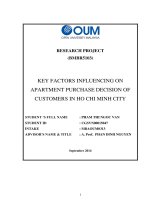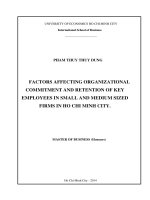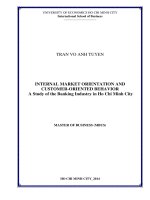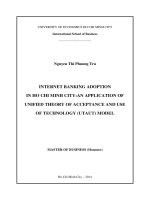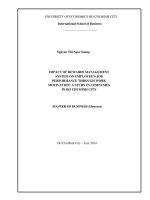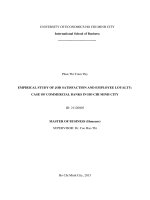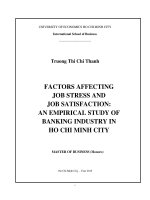Factors influencing customers behavior of butter oil substitute (bos) in ho chi minh city master project in business and marketing management
Bạn đang xem bản rút gọn của tài liệu. Xem và tải ngay bản đầy đủ của tài liệu tại đây (3.71 MB, 57 trang )
TRƯỜNG ĐẠI HỌC MỞ TP.HCM
UNIVERSITÉ LIBRE DE BRUXELLES
HO CHI MINH CITY OPEN UNIVERSITY
SOLVAY BRUSSELS SCHOOL
MBMM4
Tran Anh Tuan
Factors Influencing Customer Behavior of Butter Oil Substitute
In Ho Chi Minh City
MASTER PROJECT
MASTER IN BUSINESS & MARKETING MANAGEMENT
Tutor’s name: Dr. Ha Nam Khanh Giao
Ho Chi Minh City
(2010)
i
ASSURANCE
This thesis contains no material that has been accepted for the award of any other degree of
diploma in any university or other institution and to the best of my knowledge contains no
material previously published or written by another person, except where due reference is
made in the text of this thesis.
In this study, professional interviewers, observed by an independent quality controller and
the author of this thesis, conduct the survey. Thus, it has high level of trust, confidence and
agreement.
This information of this thesis use for limited purposes and not allow to be spread out
excepting for the jury of Solvay Business School and some marketing professionals
including the MBMM tutor.
ii
ACKNOWNLEDGEMENT
I am grateful to Dr. Ha Nam Khanh Giao for having read several chapters in my thesis and
giving me invaluable comments and suggestions. Besides, without his intellectual support
and his continuous guidance, full of patience and enthusiasm, my thesis would not have
been materialized.
I also wish to thank my study group in MBMM4 class, who gave me endless experienced
and mental support.
Finally, my thanks go to the Professors of Solvay Business School for wonderful program
and intellectual support during my MBA program.
Ho Chi Minh City, Dec 14th, 2010
---------------------------------------Signature of the student
Tran Anh Tuan
Master of Marketing & Business Management
iii
TUTOR’S COMMENTS
The thesis on the topic customer behavior of Butter oil substitute in HCM is high practical
significance. Research objectives are properly identified. Student has used the appropriate
methodology. Results obtained with the new creation with scientific content as well. In
particular, the author highlights the factors that influence customer behavior in coffee
industry. The results and conclusions of the thesis with applicable recommendations are
useful information for the organizational who want to enter the specialty fats business in
Viet Nam. However, the project also has certain limitations, such as only on HCM scale,
small samples size …
Student tries his best to conduct the thesis and has a lot of efforts to gather information as
well as to conduct a research to understand the purchase decision of customers in coffee
roasting industry.
The thesis meets requirements of MBA thesis. I suggest the committee should allow the
author to present it to your kind perusal and consideration.
Ho Chi Minh City, Dec 14th, 2010
Dr. Ha Nam Khanh Giao
iv
CONTENT
ASSURANCE .................................................................................................................... i
ACKNOWNLEDGEMENT .............................................................................................. ii
TUTOR’S COMMENTS .................................................................................................. iii
CONTENT ....................................................................................................................... iv
LIST OF FIGURES .......................................................................................................... vi
LIST OF TABLES .......................................................................................................... vii
1. EXECUTIVE SUMMARY ....................................................................................... 1
2. CHAPTER 1: INTRODUCTION .............................................................................. 2
2.1. Background introduction ..................................................................................... 2
2.2. Problem statement ............................................................................................... 2
2.3. Specialty Fats market .......................................................................................... 3
2.4. Research objectives ............................................................................................. 5
2.5. Research method ................................................................................................. 5
2.6. Scope of the project ............................................................................................. 5
2.7. Research structure ............................................................................................... 6
2.8. Framework of Research ....................................................................................... 6
3. CHAPTER 2: LITERATURE REVIEW ................................................................... 7
3.1. Chapter overview ................................................................................................ 7
3.2. Industrial Buying Behavior.................................................................................. 7
3.3. Buying Process.................................................................................................... 8
3.4. Factors Affecting Buying Process & Buying Center ............................................ 9
3.5. The buying Center ............................................................................................. 10
3.6. Choice Criteria .................................................................................................. 10
3.7. Long-term relationships in industrial markets .................................................... 12
3.8. Scale using in theoretical framework ................................................................. 14
3.9. Research model ................................................................................................. 15
4. CHAPTER 3: RESEARCH DESIGN ...................................................................... 16
4.1. Chapter Overview ............................................................................................. 16
4.2. Qualitative research ........................................................................................... 16
4.2.1. Sampling .................................................................................................... 16
4.2.2. Data collection ........................................................................................... 17
4.2.3. Data analysis .............................................................................................. 17
4.2.4. Interview results ......................................................................................... 17
4.3. Quantitative research ......................................................................................... 18
4.3.1. Questionnaire design .................................................................................. 18
4.3.2. Survey process ........................................................................................... 18
4.4. Data Analysis .................................................................................................... 19
5. CHAPTER 4: DATA ANALYSIS .......................................................................... 21
5.1. Chapter Overview ............................................................................................. 21
v
5.2. Frequency analysis ............................................................................................ 21
5.3. Descriptive analysis........................................................................................... 23
5.4. Reliability analysis ............................................................................................ 24
5.5. Factor Analysis ................................................................................................. 25
5.6. Multiple regression ............................................................................................ 27
6. CHAPTER 5: FINDINGS, RECOMMENDATIONS AND CONCLUSIONS ......... 30
6.1. Findings ............................................................................................................ 30
6.2. Recommendations ............................................................................................. 31
6.3. Conclusions....................................................................................................... 34
6.4. Limitations of the study and future research ...................................................... 35
REFERENCES................................................................................................................ 37
APPENDIX 1 - Survey questionnaire .............................................................................. 39
APPENDIX 2 – Descriptive Analysis .............................................................................. 43
APPENDIX 3 – Reliability Analysis ............................................................................... 44
APPENDIX 4 – Factor Analysis ...................................................................................... 46
APPENDIX 5 – Regression Analysis .............................................................................. 48
vi
LIST OF FIGURES
Figure 2.1: BOS and its application ................................................................................... 2
Figure 2.2: Specialty fats market ....................................................................................... 3
Figure 2.3: Calofic sales .................................................................................................... 4
Figure 2.4: Imported products............................................................................................ 4
Figure 3.1: Areas of industrial buying behavior. Adapted from Baptista and Forsberg
(1997), p. 22 ...................................................................................................................... 8
Figure 3.2: The conceptual model of selection BOS supplier ........................................... 15
Figure 5.1: Position of respondents .................................................................................. 21
Figure 5.2: BOS volume per month ................................................................................. 22
Figure 5.3: Experience of respondents with BOS in coffee roasting ................................. 22
vii
LIST OF TABLES
Table 3.1: The importance of different classical decision criteria. .................................... 11
Table 3.2: List of common choice criteria in prior studies ................................................ 12
Table 3.3: Scale using for independence variable ............................................................. 14
Table 5.1: Descriptive analysis of factors influencing customer behavior......................... 24
Table 5.2: Reliability statistic of five independence factors and one dependence factor.... 24
Table 5.3: Factor analysis with Promax method ............................................................... 26
Table 5.4: The list of new factors..................................................................................... 26
Table 5.5: Anova test....................................................................................................... 27
Table 5.6: Liner analysis ................................................................................................. 28
Table 5.7: Model Summary ............................................................................................. 29
1
Solvay Burussels School – MBA Thesis
Tutor: Dr. Ha Nam Khanh Giao
1. EXECUTIVE SUMMARY
The study was aimed at determining the impacts of factors that influence the customer
behavior of Butter Oil Substitute (BOS) in coffee roasting industry. The study was carried
out in Ho Chi Minh City on 88 customers using face to face interview and structured
questionnaire as the instruments for data collection. Questions were designed to find out
how consumers behave in relation to BOS for coffee roasting.
The study showed that the purchase of BOS in coffee roasting industry is influenced
mostly by the customer’s price consciousness, relationship between buyer and seller, and
customer service.
Implications of the study used as references for the planning of marketing strategies and as
the basis for future researches in the customer behavior with regard to bakery
customers (another application of BOS) and specialty fats in general.
2
Solvay Burussels School – MBA Thesis
Tutor: Dr. Ha Nam Khanh Giao
2. CHAPTER 1: INTRODUCTION
2.1. Background introduction
Vietnamese coffee is roasted differently from coffee in other regions of the world, a unique
process, involving butter oil and techniques that bring out the highest development of
flavor without over-roasting or burning the coffee. Coffee beans are generally roasted in
what is referred to as butter oil substitute (BOS). Butter oil substitute is a replacement for
butter oil. BOS is processed from vegetable oil instead of milk therefore it has economic.
BOS is widely used in the coffee roasting industry to replace the expensive dairy-based
butter oil. The functionality of BOS is similar to that of butter, which is to smoothly, fatty
beans. The unique characteristics of the BOS product are its strong butter flavor and a deep
yellow color. BOS has being hot in recent years in Vietnam due to low price &
convenience for coffee roasting industry.
Figure 2.1: BOS and its application
There are about 300 coffee roasters in Vietnam. All most all of coffee roasters are using
BOS to add in roasting process. Dosage is about 3% - 5%. According to the association’s
date, BOS’s volume from import statistic estimates about 7,000mt per year, almost from
Malaysia, Indonesia.
2.2. Problem statement
Wilmar International Limited is Asia’s leading agribusiness group, and their operations are
located in more than 20 countries. Wilmar’s business activities include oil palm
cultivation, oilseeds crushing, edible oils refining, consumer pack edible oils processing,
3
Solvay Burussels School – MBA Thesis
Tutor: Dr. Ha Nam Khanh Giao
specialty fats, oleo chemicals, biodiesel manufacturing, and grains processing. In Viet
Nam, Cai Lan Oil & Fats Industries (Calofic) is a market leader in cooking oils industry of
Viet Nam, through famous cooking oils brands such as Neptune, Simply, Meizan, Cai Lan,
Kiddy and Olivera. Besides, with support from Mother Company, they plan to expand
business activities in specialty fats segment. Specialty fats include BOS (butter oil
substitute), shortening, Margarine, and Hydrogenated oil. BOS extensively used for top
grade cake, cookie making and coffee roasting.
In order to exploit the existing distribution network, it is necessary for Calofic to study the
factors influencing the customer behaviors of BOS, especially for coffee roasting in Ho
Chi Minh City.
2.3. Specialty Fats market
The sales volume for the specialty fats segment in Viet Nam has reached $49 million for a
volume of 35,000Mt in 2010. Calofic’s volume has shown a steady growth since 2008: an
increase of 10.5% (Figure 3), and 5% in 2010. Imported companies are the current market
leader with 47% of the market shares in 2010. Calofic is second with 38%, the others belong to
local manufactures.
Figure 2.3: Specialty fats market
4
Solvay Burussels School – MBA Thesis
Tutor: Dr. Ha Nam Khanh Giao
Figure 2.3: Calofic sales
The imported volume was estimated to account for 47% of the specialty fats market. The
table below determines the attractiveness of a market, both now and in the future.
5,901
5,358
5,355
6,000
5,000
4,925
4,560
2,041
3,546
4,000
3,000
2,000
1,000
1,540
1,265
866
532
433
440
830
719
2008
575
2010
367
227
2009
2008
-
Figure 2.3 Imported products
2009
2010
5
Solvay Burussels School – MBA Thesis
Tutor: Dr. Ha Nam Khanh Giao
According to imported statistic, BOS is a fast growing market with an annual growth of
approximately 15%. The BOS market in Vietnam is highly competitive and fragmented due
to the presence of many trading companies, exclusively distribution of multinational
producers. There is no dominating company in the market. Customers have many
choices among imported products. In this situation, Calofic have been actively
engaged in BOS segment for coffee roasting industry in order to catch the growing
demand, and also to increase the sales in other markets where product offerings are quickly
maturing.
2.4. Research objectives
Measure the factors influencing the customer behaviors of BOS for coffee roasting
industry in Ho Chi Minh City.
Provide recommendations for management to develop marketing strategy.
2.5. Research method
Secondary research: study the customer behavior theory and model to define the
factors influencing the customer behaviors.
Primary research: conduct quantitative research to measure the relationship
between these factors and study the finding to infer the recommendations.
2.6. Scope of the project
This study focuses on coffee roasting customers in Ho Chi Minh City, who buy BOS for
coffee roasting process. BOS application in bakery and confectionery are not covered by
this research. Customers from other provinces are not chosen to be the subjects of this
study because of limit of time.
6
Solvay Burussels School – MBA Thesis
Tutor: Dr. Ha Nam Khanh Giao
2.7. Research structure
The research paper is arranged into five chapters. Chapter 1 introduces the research
background, objectives and rationale as well as the scope of the study. Literature review is
presented in chapter 2. Chapter 3 describes the methodology applied in the study. Data
analysis is presented in chapter 4. Chapter 5 summarizes the research results, provides
recommendations to company and future research.
2.8. Framework of Research
This thesis will be followed below stages:
Objectives of the Research
Literature review
Qualitative research
Theoretical framework
Research design
Data analysis
Findings, Recommendations and Conclusions
Figure 2.5: Research framework
7
Solvay Burussels School – MBA Thesis
Tutor: Dr. Ha Nam Khanh Giao
3. CHAPTER 2: LITERATURE REVIEW
3.1.
Chapter overview
The previous chapter has briefly discussed the general research background, the overview
of Vietnam specialty fats market and the key research objectives. This chapter contains an
overview of literature on industrial buying behavior. The theories regarding the buying
process, buying center, and affecting factors are all divided and presented in smaller
parts. Furthermore the concept of decision making units within industries will be
discussed and is followed by a brief discussion regarding choice criteria in industrial
buying.
3.2.
Industrial Buying Behavior
Buying behavior in this study will focus on the industrial buying behavior (hereafter IBB).
IBB is a complex process over time that involves interaction between several persons, both
within and outside an organization (Webster & Wind, 1996). Many authors have
researched this issue and there is a general agreement that the major components of
industrial buying behavior are: the buying process; the buying center; and factors affecting
the buying process and the buying center (Bapista, 2001).
Wind and Thomas (1980) have suggested that industrial buying behavior can be divided
into three different areas: buying process, buying center, and affecting factors. Each of
these areas consists of several parts, which can be seen in figure 5.
8
Solvay Burussels School – MBA Thesis
Buying process
Identification of
Needs
Identification of
Alternatives
Tutor: Dr. Ha Nam Khanh Giao
Buying center
Roles in the
BC
Factors affect BP &
BC
Environmental
Inter-organizational
Influence in
the BC
Organizational
Interpersonal
Identification of
Alternatives
Individual
Buying situation
Set Purchase and
Usage Criteria
Evaluate
Alternative
Buying
Purchase
Decisions
Post purchase
evaluation
Figure 3.2: Areas of industrial buying behavior. Adapted from Baptista and Forsberg
(1997), p. 22
3.3.
Buying Process
Wind and Thomas (1980, p. 242) have described the industrial buying process in the
following way: “From the time at which a need arises for a product or service, to the
purchase decision and its subsequent evaluation, a complex myriad of activities can take
place”. The elements in the buying process are, as mentioned in figure 3.1, overall buying
process, identification of needs, identification of alternatives, set purchase and usage
criteria, evaluate alternative buying actions, purchase decisions, and post-purchase
evaluation.
9
Solvay Burussels School – MBA Thesis
Tutor: Dr. Ha Nam Khanh Giao
Overall Buying Process
The goal with this model is to provide a useful technique of analysis for researchers
interested in the theory of decision making as well as for business executives who may
wish to review the decision making procedure of their own companies.
Identification of Needs
The identification of needs is the initiator of the buying process, and can be originated
from various sources, within or external to the buying organization (Baptista & Forsberg,
1997).
Identification of Alternatives
This particular aspect concerns the quotation selection process or rather the identification
of alternative suppliers that are selected to submit their bidding, or alternative internal
solutions. It also concerns the determination of attribute importance, which influences this
process. All these factors combined affect the buying decision.
Set Purchase and Usage Criteria
Once a set of potential suppliers is selected and the various offers/biddings are presented
this phase takes place. “Set purchase and usage criteria” focuses mainly on the assessment
of the relative importance of different purchase criteria (Baptista & Forsberg, 1997)
3.4.
Factors Affecting Buying Process & Buying Center
The major determinants of industrial buying behavior can be divided into four groups of
factors. The groups of factors mentioned by the authors are:
•
Environmental factors (environmental determinants of buying behavior which include
physical, technological, economical, political, legal, and cultural influences)
•
Organizational factors (organizational determinants of buying behavior that include
technology, structure, tasks, and people)
•
Interpersonal factors (interpersonal relationships among the members in the buying
center, that is, interpersonal determinants of buying behavior that include different roles
played by the participants, how they influence each other, and their relationships)
•
Individual factors (individual characteristics of the member, including motivation,
cognitive structure, personality, learning processes, and perceived roles.
10
Solvay Burussels School – MBA Thesis
3.5.
Tutor: Dr. Ha Nam Khanh Giao
The buying Center
The buying situation has long been recognized as vital in IBB (Webster and Wind, 1972a),
they defined the buying center as "The individuals who are related directly to the
purchasing process, whether users, buying influencers, decision makers, or actual
purchasers”. Webster and Wind (1972a) came to the conclusion that only a subset of the
organizational actors is involved in a buying situation. Further, they proposed five roles
performed by buying center members:
Users are those in the organization who use the purchased product.
Buyers are those with formal responsibility and authority for contracting with
suppliers.
Influencers symbolize those who influence the decision process by providing
information and criteria for evaluating alternative buying actions.
Deciders refer to those with authority who choose among alternative buying actions
Gatekeepers designate those who control the flow of information into buying center.
The members in the buying center interact, but they are likely to have different interests
and perceptions of reality and therefore conflicts might exist. Individuals have different
personalities, experience of their role, motivation, cognition of the problem, and
expectations. The individuals’ predispositions, preferences, and methods of making
decisions will affect the final outcome.
3.6.
Choice Criteria
In order to make the best choice and succeed in business, organizations should base their
choice of supplier upon critical evaluation criteria. Four classical criteria are quality,
delivery, price and service, seemingly the importance between these have changed during
the years (table 3.6.1) (Lehmann and O’Shaughnessy, 1974; Matthyssens & Faes1985).
11
Solvay Burussels School – MBA Thesis
Study
Tutor: Dr. Ha Nam Khanh Giao
Rank order of decision criteria
1
2
3
4
Lehman & O’Shaughnessy (1974)
Delivery Price
Quality Service
Evans (1981)
Delivery Price
Quality Service
Lehman & O’Shaughnessy (1982)
Quality
Price
Service Delivery
Wilson (1994)
Quality
Service Price
Delivery
Table 3.6.1: The importance of different classical decision criteria.
Lehman & O’Shaughnessy (1974) examined in their study the importance of different
choice criteria (attributes). Their study was conducted on the base of 17 attributes
(included in table 3.6.2) that are a breakdown of the four classical choice criteria, and thus
somewhat interrelated.
The authors found that the relevance of the attributes is mainly dependent on product type,
the buying situation at hand and the perception of the buyers. These findings were also
supported by prior work from Kelly & Coaker (1976) where five of seven investigated
choice criteria differed depending on organization as well as Dempsey’s (1978) study of
the importance of different attributes in industrial vendor selection (21 attributes where
examined and are included in table 3.6.2). Some researchers have found that generally the
purely economical factors (including delivery, capability, quality, price, repair service,
technical capability and past performance) were the most significant factors (Dempsey,
1978; Kelly & Coaker, 1976; Lehman and O’Shaughnessy, 1974).
12
Solvay Burussels School – MBA Thesis
Tutor: Dr. Ha Nam Khanh Giao
• Adjustment to company’s needs
• Production facilities
• Aid and advice
• Packaging capability
• Attitude toward buyer
• Data on reliability of product
• Performance history
• Technical specifications
• Confidence in the salesman
• Ease of operation or use
• Convenience of placing order
• Quality
• Control systems
• Ability to fill emergency orders
• Order cycle time
• Geographical location
• Reliability of delivery date promised
• Delivery capability
• Suppliers accuracy in billing
• Price
• Suppliers accuracy in order handling
• Financial position
• Financing terms
Table 3.6.2: List of common choice criteria in prior studies
Factors such as quality, delivery, price and service are often seen as significant buying
criteria when choosing suppliers. Whether these are controllable or uncontrollable depends
on the situation at hand. The emphasis of these factors changes depending on the buying
organization, specific buying situation and the individuals involved in the buying decision
(Webster, 1965).
Deng and Wortzel (1995) conducted a study of the supplier selection criteria used by US
importers in three merchandise categories. In all categories, the most important criteria
were price and product quality, followed by on time delivery. The geographical
location of the seller and the brand name was of little importance in the supplier selection
decision.
3.7.
Long-term relationships in industrial markets
There are fewer industrial buyers than consumer market customers, but the size of
individual orders can be much larger in industrial markets. For this reason individual
industrial market customers can be more important to marketers than individual consumer
market customers (these have little or no power of leverage over marketers).
13
Solvay Burussels School – MBA Thesis
Tutor: Dr. Ha Nam Khanh Giao
The importance of industrial customers can mean that they are able to negotiate on price,
terms and specifications. (The length of the negotiating period may be longer in industrial
markets.) The above two factors mean that it is both important and possible for sellers to
form close, long term relationships with buyers. There are other reasons too for the
importance of long term relationships between customers and suppliers.
This literature review suggests that five variables constitute the main explicative factors of
regular and stable industrial buying behaviors. First, it is generally admitted that trust,
commitment to the exchange relationship and satisfactory performance, are the important
characteristics of a good buyer - seller relationship. Parallel to these variables, the effect of
cooperation and non shared dependence (i.e. unilateral dependence of a customer to his
supplier) on the length of the relationship have been, too, extensively studied in the
literature (Han, et al 1993).
Satisfaction appears in the vast majority of the studies on regular and stable buying
behavior. It is, very often, considered as the determinant variable of influence on the
willingness to continue the relationship (Anderson, et al, 1990). Although some recent
studies underline that being satisfied is not enough for a customer to develop regular and
stable buying behavior (Henning-Thurau and Klee, 1997, Reicheld, 1996), satisfaction can
be considered as a necessary but not sufficient condition for the development of regular
and stable buying behavior.
Many researches also show that trust is determining in the continuity of industrial
relationships. The customer feeling confident won’t have any real reason to switch from
his supplier and, in this stable relationship; he will easily become a regular consumer.
More, as the length of the relationship increases, the feeling of confidence grows
(Anderson and Weitz, 1992). Trust seems, then, to exist for all the long-term relationship.
The situation is quite different for commitment. As a desire to develop and maintain the
relationship, commitment is a determinant of customer’s behavior only for loyal
customers. the concept can be defined as the willingness of the customer to develop
and maintain his relationship with a particular supplier (Anderson and Weitz, 1992)
14
Solvay Burussels School – MBA Thesis
Tutor: Dr. Ha Nam Khanh Giao
In conclusion, when the observed behavior is linked to positive attitudes (satisfaction, trust,
commitment), and only in that case, it reflects customer loyalty (Jarvis, Wilcox 1977).
3.8.
Scale using in theoretical framework
For this study, scale includes items of independence variable and items of dependence
variable. The table below explains the factors using in this study and their components:
Independence
Components
variable
Trust
Relationship
Pricing
Customer
service
Channeling
Quality
of product
Explain
Satisfaction
Promotion
Rebate
low initial price
Debt term
Customers’ perception of trust of seller to customers’ choices
Customers’ perception of commitment of seller to customers’
choices
How satisfaction performance influence customer buying
behavior
Customers’ buying patterns based one promotion
Customers’ buying patterns based one rebate
Customers’ buying patterns based one initial low price
Influence of debt term to customers’ choices
Solve complaint
Ability to solve customer's complaint quickly.
Commitment
Good Attitude
Importance of attitude toward customer behavior
on time delivery Ability to deliver on time indicated.
urgent order
Ability to adapt an urgent order toward customer behavior.
guarantee
Importance of guarantee delivery to customer choice
texture
Smoothly texture of product affect to customer choice.
flavor
Unique flavor of product affect to customer choice.
packing
Packing of product (tin, carton, pail) affect to customer choice.
design
Design easy to use affect to customer choice.
Table 3.3: Scale using for independence variable
15
Solvay Burussels School – MBA Thesis
3.9.
Tutor: Dr. Ha Nam Khanh Giao
Research model
The model will serve as a framework for the research design to explore factors that
determine BOS purchase. Hypothesis of the model:
H1: The Relationship between buyer and seller impacts on supplier selection of BOS in
coffee roasting industry.
H2: The customer service impacts on supplier selection of BOS in coffee roasting
industry.
H3: The Channeling impacts on supplier selection of BOS in coffee roasting industry.
H4: The Pricing impacts on supplier selection of BOS in coffee roasting industry.
H5: The quality of product impacts on supplier selection of BOS in coffee roasting
industry.
According to what mentioned above and based on qualitative research, the hypothesis for
this study is presented as below:
Relationship
Service
Selection
supplier
Delivery
Price
Product
Figure 3.9: The conceptual model of selection BOS supplier
16
Solvay Burussels School – MBA Thesis
Tutor: Dr. Ha Nam Khanh Giao
4. CHAPTER 3: RESEARCH DESIGN
4.1.
Chapter Overview
This research methodology gave us guidelines for how we should gather needed
information for our research and how to process it. This increased the possibility to receive
appropriate answers to our research questions and also to make valuable conclusions. The
starting point of any research process is the identification of the research objectives. The next
step is to establish plans of how the objectives are met and how information is to be obtained.
The research design in this study was based on the research objectives, the availability of
secondary data and the available resources.
Both qualitative and quantitative methods were used. According to Trong & Ngoc (2008)
there are three ways of conducting exploratory research: (1) search for literature; (2) talking
to experts; and (3) conducting focus group interviews. Face to face interview and focus
group was intended for exploratory purpose which provided qualitative information. The
explored information was then used to construct the questionnaire for descriptive purpose.
These are to be answered with a method representing a measuring quantitative data. The
approach to this study led to that the gathered information was expressed through
words with standardized data and was analyzed using SPSS.
4.2.
Qualitative research
The purpose of the qualitative study is to explore potential factors that may have an impact
on the buying decision of customers in relation to coffee roasting industry. The method
used is face to face interview and focus group.
4.2.1. Sampling
In order to provide content validity, author arrange interviews with managers at Calofic,
sales & marketing staffs, R&D staffs and distributors to get their advice about
questionnaire to make it more consistent with the purpose of this research. One group of
six distributors was recruited for focus group discussion. Focus interview by face to face
applied for managers, staff of sales & R&D in Calofic.
17
Solvay Burussels School – MBA Thesis
Tutor: Dr. Ha Nam Khanh Giao
4.2.2. Data collection
Questions were asked about factors determining purchase decision and perception about
these factors for coffee industry. The interview conducted during 10th - 12th Sep, 2010.
4.2.3. Data analysis
Different opinions from the interviews were classified and grouped factors that may
influence the buying behavior identified. These factors are introduced in the questionnaire
for confirmatory and quantitative purposes.
4.2.4. Interview results
Data were drawn from the results of face to face discussions. In general, respondents
‘opinions and attitudes were very diverse. Factors that may influence
the customer
buying behavior include those belong to product characteristics such as texture,
flavor, packing, design. For pricing factor, promotion, rebate, low initial price also have
significant affect. Customer characteristics that may have an impact on the purchasing
behavior are position, experience, knowledge about the product, age, and their volume.
Other influencers are relationship, service, and channeling.
Focus interviews with expert and staffs of Calofic indicated that:
Most of the participants are quality-conscious rather than price-conscious.
Relationship between buyer and seller play an important role in the consumer’s
decision making. The relationship includes trust between two parties,
commitment of supplier for their products and services, and satisfaction
performance during transaction.
Customer service, channeling are used by customers as indicators for perceived
quality.
In general, customers have limited knowledge about BOS products and show a
relatively low involvement in the buying decision process.
Discussions among six distributors in focus group revealed similar customer behaviors:
Customers tend to rely on sales personnel for their purchase decision.
Customers are likely to judge product quality based on price and customer
service.
Customers always bargain for price.
